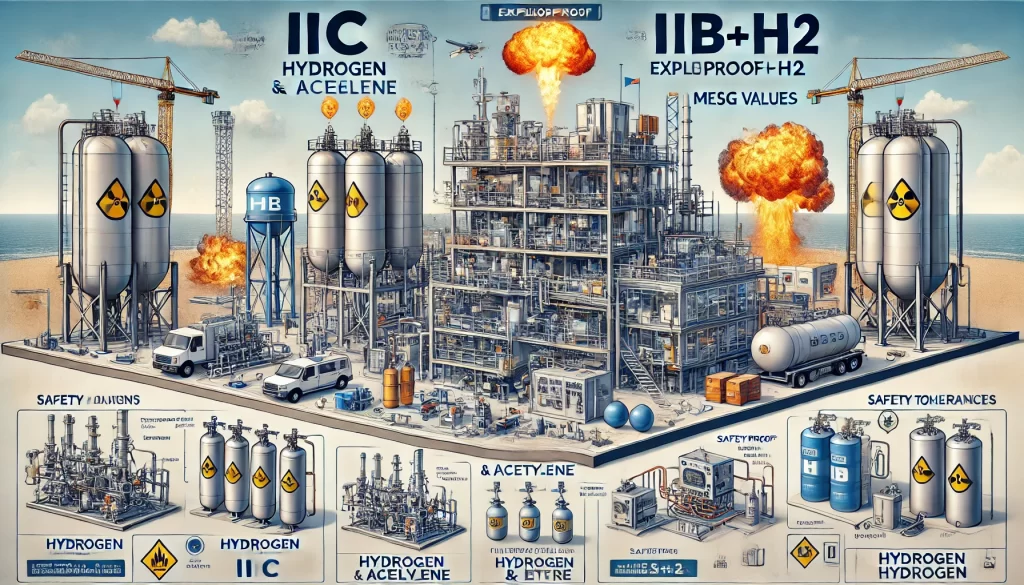Explosion-proof equipment is essential in industries dealing with hazardous atmospheres to prevent accidents caused by explosive gases. Among the classifications for such equipment, ⅡC and ⅡB+H2 are two critical categories. Understanding their differences is vital to ensure safety and compliance with industry standards.
Background on Explosion-Proof Classifications
The classification of explosion-proof equipment is governed by international standards such as IEC 60079. The Ⅱ category is specifically for equipment used in explosive gas atmospheres outside coal mines. Within this category:
- ⅡB and ⅡC further classify gases based on their flammability and explosive characteristics.
- The addition of “H2” in ⅡB+H2 indicates a specific focus on hydrogen, a highly explosive gas.
Definition of ⅡC and ⅡB+H2
ⅡC Classification
- Highest safety level in the Ⅱ group.
- Designed for gases that are extremely flammable and explosive, such as:
- Hydrogen (H2)
- Acetylene (C2H2)
- Requires equipment with superior ignition protection and smaller tolerances for gas ignition.
- Typically involves materials and designs that withstand higher explosion risks.
ⅡB+H2 Classification
- Focuses on ⅡB gases like ethylene (C2H4) while also accommodating hydrogen (H2).
- Provides a compromise solution for environments with mixed gas types.
- Does not cover gases like acetylene, which are unique to the ⅡC category.

Key Technical Differences
The technical distinctions between these two classifications include:
Minimum Ignition Energy (MIE)
- ⅡC gases have a lower MIE, meaning they require less energy to ignite. Equipment for ⅡC environments must prevent ignition even in extremely sensitive conditions.
- ⅡB+H2 equipment is designed for gases with higher MIE compared to ⅡC gases.
Minimum Experimental Safe Gap (MESG)
- ⅡC: ≤ 0.5 mm
- ⅡB+H2: Between 0.5 mm and 0.9 mm MESG measures the smallest gap through which an explosion can propagate. A smaller MESG means higher explosion risk and requires stricter design standards.
Flameproof Design
- ⅡC requires more robust flameproof construction to prevent gas ignition in high-risk environments.
- ⅡB+H2 uses less stringent design criteria, making it less expensive but suitable for its intended use cases.
Cost and Material Requirements
- ⅡC equipment involves higher costs due to enhanced safety features and more durable materials.
- ⅡB+H2 equipment offers cost savings for less hazardous environments.
Applications
ⅡC Equipment
- Suitable for environments with:
- Hydrogen
- Acetylene
- Other high-risk gases
- Commonly used in:
- Chemical plants
- Oil refineries
- Laboratories with acetylene applications
ⅡB+H2 Equipment
- Designed for environments with:
- Hydrogen
- Ethylene
- Found in:
- Fuel cell systems
- Certain chemical processing units
- Environments without acetylene but with hydrogen risks

Selecting the Right Equipment
When choosing between ⅡC and ⅡB+H2 explosion-proof equipment, consider the following factors:
Gas Composition
- If acetylene is present, ⅡC equipment is mandatory.
- If only hydrogen and ethylene are involved, ⅡB+H2 can be sufficient.
Risk Assessment
- Analyze the likelihood and impact of explosions in the area.
- Higher risk environments require ⅡC for maximum safety.
Budget and Efficiency
- ⅡB+H2 is a cost-effective choice for environments without acetylene.
- Investing in ⅡC ensures compliance with stricter safety standards.
Conclusion
The choice between ⅡC and ⅡB+H2 explosion-proof equipment depends on the specific gases present and the risk level of the environment. While ⅡC equipment offers the highest safety standard for the most hazardous gases, ⅡB+H2 provides a tailored solution for hydrogen and ethylene applications. Careful assessment of operational requirements, gas types, and safety regulations is critical to making the right selection and ensuring both safety and cost-effectiveness.
